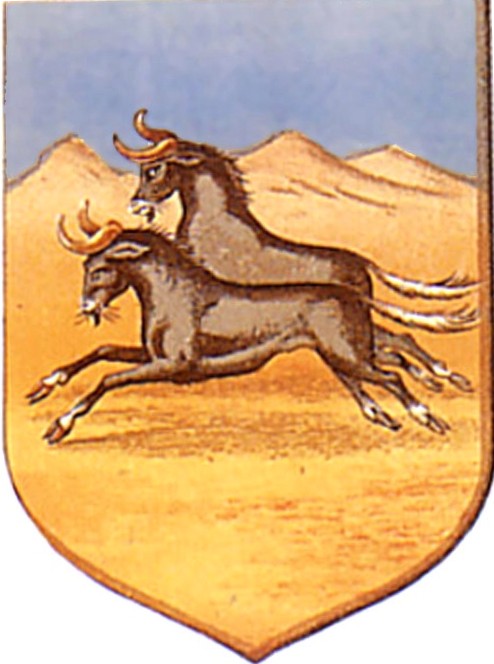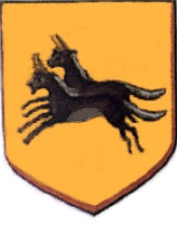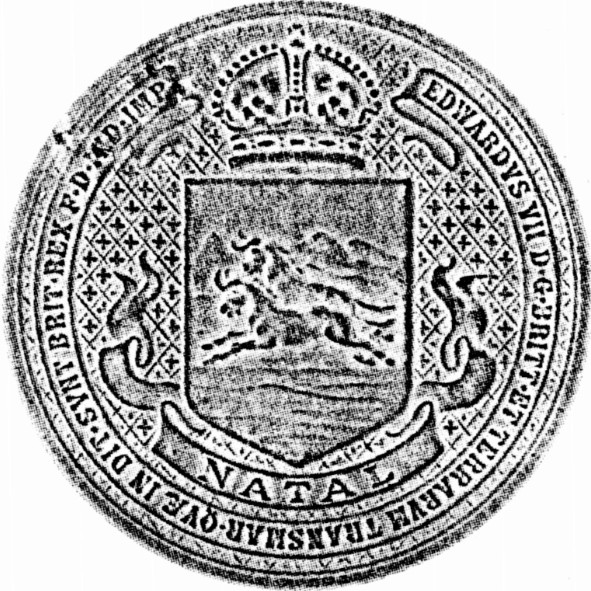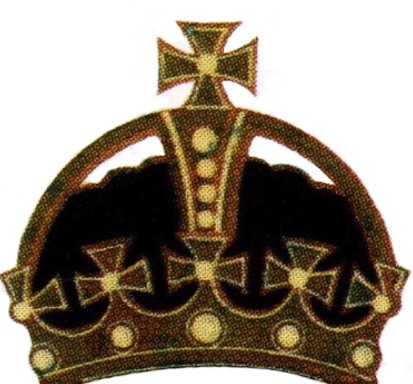

Province of Natal
Provincie Natal

The Province of Natal continued to use the arms granted to the Colony of Natal by Royal Warrant on 16 May 1907, the blazon of which reads:
Arms: Azure in front of mountains and on a plain two Black Wildebeesten in full course at random, all proper.
About the province:
The colony formally became a province of the Union of South Africa on 31 May 1910. It was the only one of the four provinces not to have a national capital city (the functions of legislature, administration and judiciary being split between Cape Town, Pretoria and Bloemfontein). The province’s own legislature, seated in Pietermaritzburg, was called the Natal Provincial Council. The administration was headed by an Administrator appointed by the Governor-General with the advice of the Prime Minister, assisted by an Executive Committee whose members had to be elected members of the Provincial Council.
Heraldic developments:
 Arms were granted to the province by the College of Arms on 4 May 1911, in the form of the Natal quarter of the Union arms, but the arms so granted were not even communicated to the province (see Union of South Africa) and, despite the technical invalidity of the 1907 grant, this continued in use.
Arms were granted to the province by the College of Arms on 4 May 1911, in the form of the Natal quarter of the Union arms, but the arms so granted were not even communicated to the province (see Union of South Africa) and, despite the technical invalidity of the 1907 grant, this continued in use.
The Natal quarter in the Union arms is a vast improvement over the 1907 grant, since the landscape background is simplified to a plain gold field. However, the province continued to use the arms granted in 1907, despite doubts expressed as to whether the province was entitled to use the arms granted to the colony.

The actual display of the arms, however, followed the pattern first used in the Edward VII seal, where the shield was ensigned with an imperial crown and a scroll beneath the shield showed the colony’s name, NATAL.
This was a style of display arrived at in 1910, when the shield was ensigned with the type of crown then in vogue – the Tudor crown preferred by King Edward VII. This was done even though the warrant of 1907 did not mention a crown of any kind.
The Official Gazette of Natal displayed the British royal arms on its masthead until the end of 1929, when they were replaced by the provincial arms. However, the Provincial Council consistently used the colonial arms from the time of Union onwards.
Name of the province:
Whereas the Colony of Natal had only been named officially in English, the province could be named in either English and Dutch, both being official languages. In 1925 Afrikaans attained official status alongside Dutch, and the Afrikaans name changed by one letter only to Provinsie Natal. Since Afrikaans predominated only in the northern parts of the province, this form of the name was little used in Pietermaritzburg or Durban. Also in 1925, Afrikaans attained recognition as a medium of instruction in schools.
Natal Province
Provinsie Natal

Embellished colonial arms formally registered:
State Herald F G Brownell writes that in 1950 the Secretary for the Interior took up the question of provincial arms with the Prime Minister. “Each of the Provinces was asked to indicate which arms they desired to adopt. On behalf of Natal the Administrator-in-Executive Committee decided that the Province’s arms should be those granted by Royal Warrant in 1907, but with the addition of the crown and the word NATAL – as the arms had in practice been borne since 1910.”
Brownell next quotes a minute from the Secretary to the Prime Minister to the Secretary for the Interior, undated but clearly subsequent to the death of King George VI in 1952:
“The matter was submitted to Her Majesty the Queen, in accordance with the Prime Minister’s instructions, with the intimation that if formal approval could not be afforded to the Arms, namely, those of the Transvaal and the Orange Free State, which do not appear to conform to the laws of heraldry, without causing The Queen embarrassment and if Her Majesty would therefore prefer not to be associated with them, Ministers would not wish to take any further steps towards obtaining such formal approval. It was further intimated that in that event, Ministers proposed to seek Her Majesty’s approval for the withdrawal of the Royal Warrant of the 4th May 1911, and since it would be inappropriate to issue new Warrants in the case of the Cape and Natal Provinces only, to give informal permission to all Four of the Provinces to use the arms which they respectively desire. “A reply has now been received from the Palace to the effect that Her Majesty will be glad to adopt the foregoing proposal whereby the Royal Warrant of the 4th May 1911, which granted certain Arms to the Provinces which they no longer desire, is withdrawn and informal permission simultaneously given to them to use the Coats of Arms which they desire to adopt. Her Majesty feels that it is right and proper that the choice of their Coats of Arms should rest with the Provinces themselves. In these circumstances a new Royal Warrant will not be sought. “Steps are being taken for the withdrawal of the above mentioned Warrant and you will be informed when formal approval therefor has been obtained.” In 1954 the Administrators of the four provinces were notified: “. . . Her Majesty the Queen has approved, formally, the withdrawal, with effect from the 22nd June, 1954, of the Royal Warrant of the 4th May 1911, in terms of which certain Coats of Arms were granted to the Provinces. Those Provinces which have not, as yet, done so, are now, at liberty to use the Coat of Arms which they desire to adopt. “The Secretary for External Affairs states that the Garter Principal King of Arms . . . has suggested on being informed of the withdrawal of the Royal Warrant and of the permissions granted to the Provinces, that the new Coats of Arms be registered with the College [of Arms].” Brownell continues: “Consent was simultaneously granted for Natal to use the crown, if it so wished. Natal duly applied to the College of Arms to have its arms recorded in the form in which it desired to use them, and this was effected in 1955.” However, an anomaly in the arms as recorded by the College was that the crown was not changed to the St Edward’s crown adopted in 1952 as the official symbol of the monarchy. However, it was also not strictly the Tudor crown adopted during the reign of King Edward VII (1901-10). Brownell notes the points of difference between the “Natal crown” and an actual royal crown as being: 1. The rim of the circlet is enhanced with crosses paty, not alternating crosses paty and fleurs-de-lys. 2. The circlet is not jewelled, but merely has an embossed pattern. 3. The arches are not encrusted with pearls. 4. The crown is not surmounted by an orb ensigned with a cross paty; the orb is omitted entirely. 5. The cap of estate within the crown is not crimson (as in the heraldic crown) or even purple (as in the real State Crown) but black. 6. The ermine lining of the cap does not appear below the rim. Brownell concludes: “In the absence of a Royal Warrant authorising the use of a British Royal Crown in conjunction with the Natal coat of arms it must be concluded that the College of Arms did not in fact intend to depict either a specific Royal crown or the conventionalised British heraldic crown, but merely a gold crown in general.” However, this anomaly had not been brought to the attention of the Bureau of Heraldry (created by an Act of Parliament passed in 1962), and when the province’s arms were registered under the Act in October 1967, the certificate referred to “the crown of St Edward”, and the illustration depicted this type of crown. The Provincial Secretary informed the State Herald that this was “not acceptable to the Administrator-in-Executive Committee” and requested a fresh certificate. The Bureau complied, and under certificate of registration No 102, issued on 29 January 1969, registered the arms following the blazon of 1907 but with the additional wording: . . . the shield ensigned with a crown consisting of a circlet with eight crosses pattée and four arches surmounted of a cross pattée Or, with a cap of estate Sable. The illustration included a scroll beneath the shield bearing the word NATAL, but no mention was made of it in the blazon, following the practice of the College of Arms to omit mention of mottoes. However, in this case it is not the motto, but the name of the province, and it is bad heraldic usage to include the name of the authority in its arms. The province nonetheless insisted that this be included in the blazon, and in 1985 a notice was gazetted to the effect that the word NATAL appears on a riband beneath the shield. Territorial and constitutional changes: Although the indigenous people were not originally all subject to the King of the Zulu, events during the 19th and 20th centuries had led to most or all of the chiefs of these diverse clans acknowledging allegiance to the royal house. The language spoken by the men of the clans was uniformly isiZulu (in a range of dialects), although in a few clans the women spoke other languages. Consequently all the province’s tribal trust lands were in 1970 grouped together under the KwaZulu Territorial Authority, and on 30 March 1972 acquired its own Legislative Assembly. KwaZulu chose not to accept the “independence” offered by the South African Government. Transkeian “independence” in 1976 resulted in the isolation of Griqualand East (magisterial district of Mount Currie) from the rest of the Cape Province. Although the Constitution required any changes in provincial boundaries to be approved by the affected provinces, the central government decided (without formal consultation with the provinces) to hand Griqualand East to Natal. Since Natal had long coveted the area, and its white land-owners had strong ties with the province, this arrangement was accepted by the administration in Pietermaritzburg. The administration of the Griqualand East Divisional Council became a local office of the Natal Provincial Administration, and the municipalities of Kokstad and Matatiele became Natal boroughs. Under the 1984 Constitution the Provincial Council was abolished. The Administrator, still a presidential appointee (the prerogative having passed to the State President in 1961), now co-opted his Executive Committee instead of drawing it from elected legislators. The ostensible aim of this change was to broaden the base of the provincial administration to include people of other races (only whites had been able to be members of the Provincial Council), but by and large those appointed were lackeys of President P W Botha. In 1994 the province was one of two that remained more or less the same as before. It was merged with KwaZulu and became known formally as KwaZulu-Natal. The boundary commission allocated to KwaZulu-Natal the left bank of the Phongolo River in its lower reaches, thereby eliminating the panhandle of the Piet Retief district (in the Eastern Transvaal, now Mpumalanga) embracing Swaziland on its southern side. In addition the commission recommended the transfer of Griqualand East to the Eastern Cape Province. However, this change was resisted, and although both provinces have set up administrative arrangements in Griqualand East, the area remains effectively under the control of KwaZulu-Natal, not the Eastern Cape. Comments, queries: Mike Oettle

Natal included large areas of tribal trust lands, partly originating in the “locations” which Theophilus Shepstone had placed like a patchwork quilt across the pre-1887 Colony of Natal, and partly in the parts of Zululand and the Lake St Lucia and Ingwavuma territories which had remained in the hands of the indigenous people.
